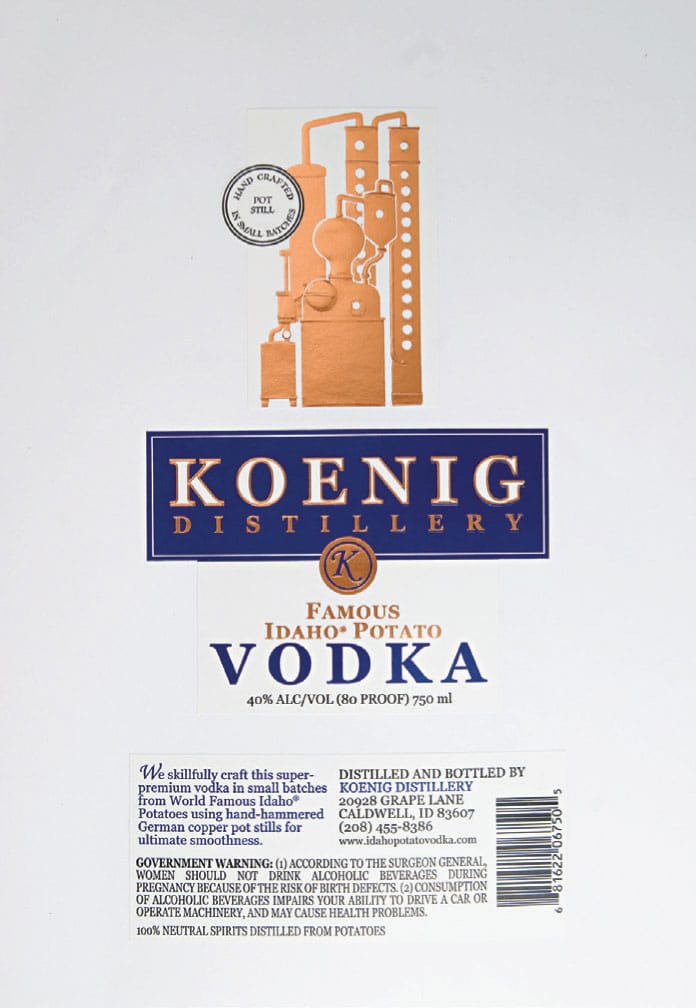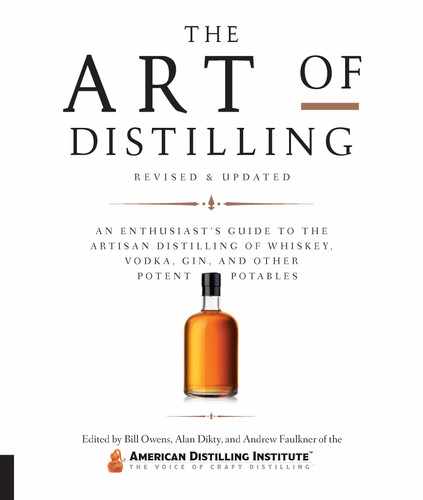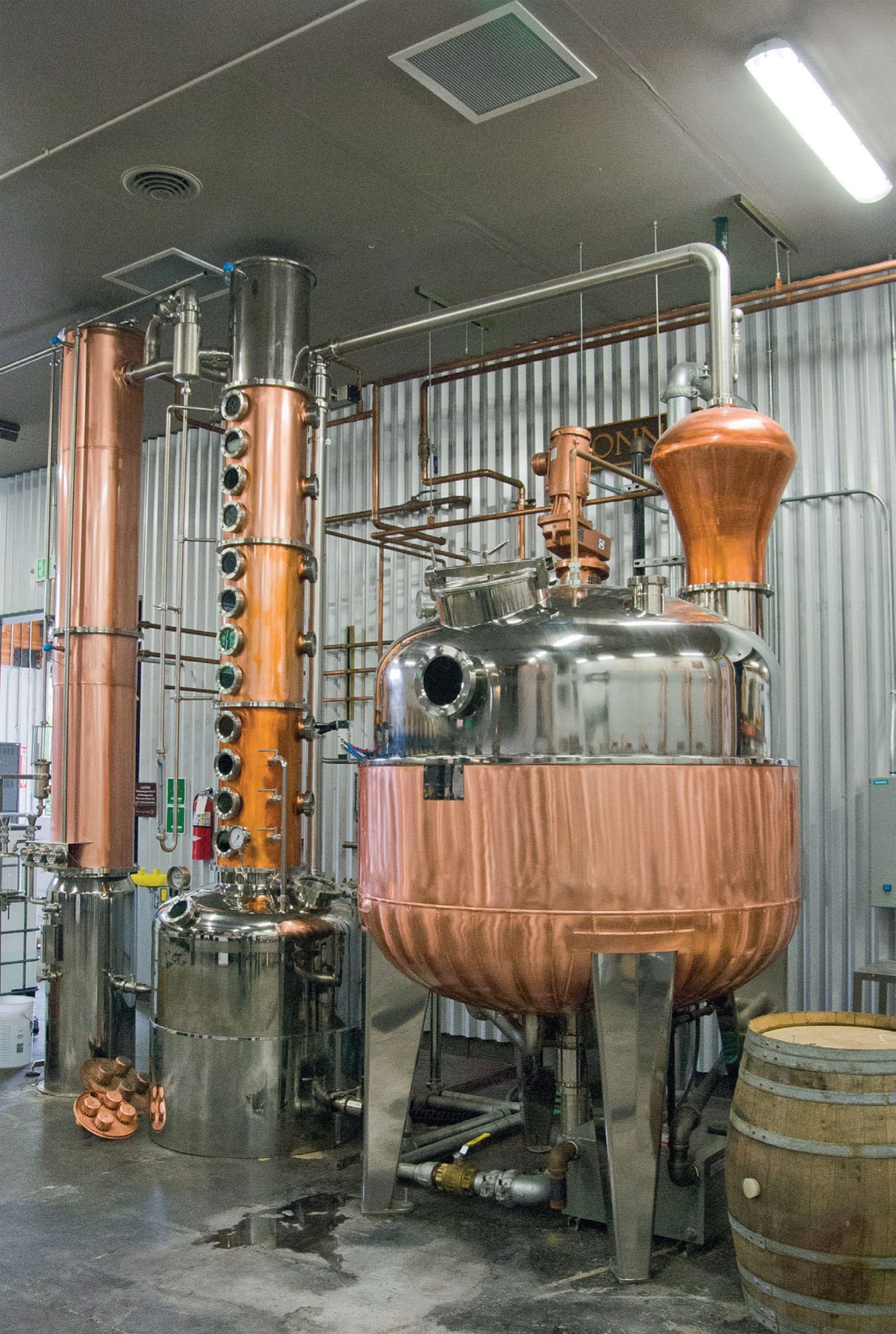Chapter 4
VODKA
AS the story goes, in 988, the Grand Prince of Kiev (Ukraine) decided it was time for his people to be converted from their pagan ways to one of the monotheistic religions that held sway to the south. First came the Jewish rabbis.
He listened to their arguments, was impressed, but ultimately sent them away after noting that the followers of Judaism did not control any land. Next came the Muslim mullahs. Again, he was impressed, both with their intellectual arguments and the success of Islam as a political and military force. But when he was told that Islam prohibited alcohol, he was dismayed and sent them away. Finally, came the Christian priests, who informed him that not only could good Christians drink alcohol, but also that wine was required for church rituals such as communion. That was good enough for the Grand Prince, and on his command his subjects converted en masse to Christianity.

Pipes and rectification columns at Sutherland Distilling Company, Livermore, CA.
“THE RELATIONSHIP BETWEEN A RUSSIAN AND A BOTTLE OF VODKA IS ALMOST MYSTICAL.”
Richard Owen, British scientist and drinking buddy of Charles Darwin
THE HISTORY OF VODKA
Historically, the Slavic peoples of the north and their Scandinavian neighbors took alcoholic drinks very seriously. The extreme cold temperatures of winter inhibited the shipment of wines and beers because these low-proof beverages could freeze during transit. Until the introduction of distilling into Eastern Europe in the 1400s, strong drink was made by fermenting wines, meads and beers, freezing them and then drawing off the alcoholic slush from the frozen water.
The earliest distilled spirit in Eastern Europe was made from mead (honey wine) or beer and was called perevara. The word vodka (from the Russian word voda, meaning “water”) was originally used to describe grain distillates that were used for medicinal purposes. As distilling techniques improved, vodka (wodka in Polish) gradually came to be the accepted term for beverage spirit, regardless of its origin.
THE BASIS OF VODKA
Vodka is made by fermenting and then distilling the simple sugars from a mash of pale grain or vegetal matter, which can be potatoes, molasses, beets or a variety, of other plants. Rye is the classic grain for vodka, and most of the best Russian and Polish brands are made exclusively from a rye mash. Swedish and Baltic distillers are partial to wheat mashes, although wheat is also used farther east. Potatoes are looked down on by Russian distillers, but they are held in high esteem by some of their Polish counterparts. Molasses is widely used for inexpensive, mass-produced brands of vodka. American distillers use the full range of base ingredients.
VODKA IN RUSSIA
Russians firmly believe that vodka was created in their land. Commercial production was established by the fourteenth century. In 1540, Czar Ivan the Terrible established the first government vodka monopoly. Distilling licenses were handed out to the boyars (the nobility), all other distilleries were banned, and moonshining became endemic.
Vodka production became an integral part of Russian society. Landowners operated stills on their estates and produced high-quality vodkas that were flavored with everything from acorns to horseradish to mint. The czars maintained test distilleries at their country palaces. In 1780, a scientist at one such distillery invented charcoal filtration to purify vodka.
By the eighteenth and into the nineteenth century, the Russian vodka industry was considered technologically advanced. New stills and production techniques from Western Europe were eagerly imported and utilized. State funding and control of vodka research continued. Under a 1902 law, “Moscow vodka,” a clear 40 percent ABV rye vodka without added flavorings and soft “living” (undistilled) water, was established as the benchmark for Russian vodka.

Fremont Mischief Distillery.
The Soviet Union continued government control of vodka production. All distilleries became government owned, and while the Communist Party apparatchiks continued to enjoy high-quality rye vodka, the proletariat masses had to make do with cheap spirits.
Vodka production in the current Russian Federation has returned to the pre-revolutionary pattern. High-quality brands are again being produced for the new social elite and for export, while the popularly priced brands are still being consumed, well, like voda.
VODKA IN POLAND
The earliest written records of vodka production in Poland date from the 1400s, though some Polish historians claim that it was being produced around the southern city of Krakow at least a century earlier. Originally known as okowita (from the Latin aqua vita, “water of life”), it was used for a variety of purposes in addition to beverages. A 1534 medical text defined an aftershave lotion as “vodka for washing the chin after shaving.” Herbal-infused vodkas were particularly popular as liniments for the aches and pains of life.
In 1546, King Jan Olbracht granted the right to distill and sell spirits to every adult citizen. The Polish aristocracy, taking a cue from their Russian peers, soon lobbied to have this privilege revoked and replaced by a royal decree that reserved to them the right to make vodka.
Commercial vodka distilleries were well established by the eighteenth century. By the mid-nineteenth century, a thriving export trade had developed, with Polish vodkas, particularly those infused with small quantities of fruit spirit, being shipped throughout northern Europe and even into Russia.
With the fall of Communism in the late 1980s, the vodka distilleries soon returned to private ownership. Nowadays, high-quality Polish vodkas are exported throughout the world.
VODKA IN SWEDEN
Vodka production in Sweden, which dates from the fifteenth century, has its origins in the local gunpowder industry, where high-proof spirit (originally called brännvin) was used as a component of black powder for muskets. When distilleries were licensed to produce beverage alcohol (primarily spice-flavored aquavit, but also vodka), it was with the understanding that gunpowder makers had first priority over beverage consumers.
Home distilling was long a part of Swedish society. In 1830, there were more than 175,000 registered stills in a country of fewer than three million people. This tradition, in a much diminished and illegal form, still continues to this day. Modern Swedish vodka is produced by the Vin & Sprit state monopoly.

Putting labels over the caps of freshly filled bottles of Prezydent Vodka at Polmos Łódz in Łódz, Poland.
VODKA IN THE UNITED STATES
Vodka was first imported into the United States in significant quantities around the turn of the twentieth century. Its market was immigrants from Eastern Europe. After the repeal of Prohibition in 1933, the Heublein Company bought the rights to the Smirnoff brand of vodka from its White Russian émigré owners and relaunched vodka into the U.S. market. Sales languished until an enterprising liquor salesman in South Carolina started promoting it as “Smirnoff White Whisky—No taste. No smell.” Sales boomed and American vodka, after marking time during World War II, was on its way to marketing success. The first popular vodka-based cocktail was a combination of vodka and ginger ale called the Moscow Mule. It was marketed with its own special copper mug, examples of which can still be found on the back shelves of liquor cabinets throughout the United States.
Today, vodka is the dominant white spirit in the United States, helped along by its versatility as a mixer and some very clever advertising campaigns. The most famous of these was the classic double-entendre tagline: “Smirnoff—It leaves you breathless.”
The majority of American craft distillers are vodka producers. They are divided between those who purchase neutral grain spirit (NGS) from a third-party supplier and then rectify it in their own facility, and a relative handful of operations that produce and distill their own wash to make vodka. This is actually a serious challenge for craft distillers with pot stills, because it is difficult to produce a high-proof neutral grain spirit without using a column still.

Ready-to-drink (RTD) cocktails are becoming more popular at craft distilleries. Vodka Mule by Cutwater Spirits, San Diego, CA.
The best-known, and best-selling, vodka is Tito’s Handmade Vodka from the distillery of the same name in Austin, Texas. Despite its carefully cultivated market image as a “handmade” craft product, the base spirit is NGS (neutral grain spirit) produced, at various times, at ethanol plants and national distilleries in the Midwest. For the record, every other major domestic brand of vodka, and many of the craft brands, too, are made the same way.

Charcoal filtration used in making vodka at Colorado Pure Distilling.
DISTILLATION OF VODKA
Vodka is distilled in the manner described in the introductory chapter of this book (see here). The choice of pot or column stills does, however, have a fundamental effect on the final character of the vodka. All vodka comes out of the still as a clear, colorless spirit. But vodka from a pot still (the sort used for cognac and Scotch whisky) will contain some of the delicate aromatics, congeners, and flavor elements of the crop from which it was produced. Pot stills are relatively inefficient, and the resulting spirit from the first distillation is usually redistilled (rectified) to increase the proof of the spirit. Vodka from a more efficient column still is usually a neutral, characterless spirit.
Except for a few minor exceptions, vodka is not put into wooden casks or aged for any extensive period of time. It can, however, be flavored or colored with a wide variety of fruits, herbs, and spices.
CLASSIFICATIONS OF VODKA
There are no uniform classifications of vodka. In Poland, vodkas are graded according to their degree of purity: standard (zwykly), premium (wyborowy) and deluxe (luksusowy). In Russia, vodka that is labeled osobaya (special) is usually a superior-quality product that can be exported, while krepkaya (strong) denotes an overproof vodka of at least 56 percent ABV.
In the United States, domestic vodkas are defined by U.S. government regulation as “neutral spirits, so distilled, or so treated after distillation with charcoal or other materials, as to be without distinctive character, aroma, taste, or color.” Because American vodka is, by law, neutral in taste, there are only very subtle distinctions between brands. Many drinkers feel that the only real way of differentiating between them is by alcohol content and price.

Maine Distilleries uses locally sourced potatoes to make its Cold River Vodka.
The hybrid pot still at Heritage Company in Gig Harbor, WA, with a thumper and two columns can make vodka in one pass.

Prentis Orr, left, and Barry Young, founders of Pennsylvania Pure Distillery, stand in front of a chalkboard diagram that outlines how they make their Boyd & Blair Potato Vodka from scratch in Glenshaw, PA.
VODKA REGIONS
EASTERN EUROPE
This is the homeland of vodka production. Every country produces vodka, and most also have local, flavored specialties. Russia, Ukraine, and Belarus produce the full range of vodka types, and they are generally acknowledged to be the leaders in vodka production. Only the better brands, all of which are distilled from rye and wheat, are exported to the West.
Poland produces and exports both grain- and potato-based vodkas. Most of the high-quality brands are produced in pot stills.
The Baltic States of Estonia, Latvia, and Lithuania, along with Finland, produce primarily grain-based vodkas, mostly from wheat.

Tim Smith of Ogden’s Own Distillery hikes into Ogden Canyon to collect spring water from its source and uses it to reduce Five Wives Vodka to proof.
WESTERN EUROPE
This region has local brands of vodka wherever there are distilleries. The base for these vodkas can vary from grains in northern countries, such as the United Kingdom, Holland, and Germany, to grapes and other fruits in the winemaking regions of France and Italy. Sweden has, in recent decades, developed a substantial export market for its straight and flavored wheat-based vodkas.

Zubrówka vodka by Polmos Bialystocka is flavored with buffalo grass from the Bialowieza forest in Poland. The vodka has a yellow-green tinge (not shown) from the grass infusion.

Label for Koenig’s Famous Idaho Potato Vodka, by the Koenig Distillery and Winery.
NORTH AMERICA
The United States and Canada produce vodkas from almost every substrate that can be distilled including, but not limited to, grains, grapes, apples, potatoes, molasses, sweet potatoes, maple syrup, milk, and honey. Stills that have rectification columns large enough to produce vodka are more expensive and refining a spirit to neutral consumes more energy than other spirits, so making vodka from scratch is costly. Many brands are produced by purchasing neutral spirits in bulk, watering to proof and bottling the distillate. A good way to tell if a vodka is made from scratch is to read the origin statement, usually found on the back of the bottle. If the label says “distilled and bottled by…,” then legally the Distilled Spirits Plant (DSP) has to have distilled it. If the origin statement says “Produced by…” or “Bottled by…,” then it is reasonable to assume that the vodka was made from neutral spirit purchased in bulk from a large factory distillery.
American vodkas are, by law, neutral spirits, so the distinction between nonflavored brands has traditionally been more a matter of price and perception than taste. In order to distinguish their spirits in the market, a number of craft distillers are now making vodkas that show a little more of the residual aromas and flavors of the base material. Some good examples of this are Jackson Hole Still Works Highwater Vodka (corn and oats), Caledonia Spirits Barr Hill Vodka (Honey), Harvest Spirits Core Vodka (apple), and Central Standard Spirits Wisconsin Rye Vodka.
A number of flavored vodkas are also produced both by the major distillers and by an assortment of craft distillers.
VODKA IN UNEXPECTED PLACES
The Caribbean produces a surprising amount of vodka, all of it from molasses. Most of it is exported for blending and bottling in other countries.
Australia produces (and consumes) vast quantities of molasses-based vodka, but few are exported.
Asia has a smattering of local vodkas, with the best coming from Japan.

Core Vodka by Harvest Spirits is distilled from apples.

Elk Rider Wheat Vodka by Heritage Distilling Company earned a Gold Medal, Best of Category, Best of Class, in the American Distilling Institute’s 10th Annual Judging of Craft Spirits, 2016.

Sagaponacka Wheat Vodka by Sagaponack Farm earned a Double Gold Medal in the American Distilling Institute’s 2018 International Judging of Craft Spirits.
THE BIGGEST-SELLING SPIRIT IN THE WORLD THAT YOU HAVE NEVER HEARD OF
In early 1935, during the Chinese Civil War between the Communist Red Army and Nationalist Kuomintang (KMT), retreating Red Army units on what became known as the Long March, paused in the city of Maotai in the south-central province of Guizhou. The KMT Air Force had been bombing and strafing the Red Army without pause for weeks, but it suddenly stopped this assault when the troops entered the town, and did not renew the attack until the Red Army had left Maotai and moved on. In turn, the Communist forces left the town untouched. The reason for this unofficial truce was that the town of Maotai was the home the distilleries making mao tai, a type of spirit called baijiu that was held in high regard by both sides in the civil war. Politics is one thing, but the possible loss, to both Communists and Nationalists, of what most people in China agreed was the country’s finest spirit, was inconceivable and unacceptable.

Kweichow Moutai, is a variety of baiju from China.
Mao tai is probably the best known (or more probably the only known) Chinese spirit outside of China. But it is by no means the only variety of baijiu, which is made pretty much everywhere in China where grain is grown. In simple terms, mao tai is to baijiu in China what Cognac is to brandy in France: the most famous type of a wide range of spirits. Baijiu, which literally means “white alcohol” or liquor, is a distilled spirit made primarily from sorghum or wheat mash, although virtually every other sort of cultivated grain including millet, barley, corn, and even rice can also be utilized.
Alcohol production in what is now China dates back far into Neolithic times (at least 7000 BC), with a variety of simple beers and fruit wines being produced. But unlike the ancient Middle East and Europe, where low-alcohol fermented grain beverages and wines were often a substitute for polluted water, the Chinese also had tea, made using boiled water that was safe to drink. This alternative source of a safe, daily beverage allowed the governments of the early kingdoms, and later the national dynasties, to control and tax alcohol products. Alcoholic beverages, if not quite a luxury, were at least not a necessity for healthy living.

VINN Baiju is made from a qu fermentation in Wilsonville, OR, by an ethnic Chinese family, whose patriarch fled Vietnam with the “boat people” following the fall of South Vietnam in the late 1970s. The VINN Distillery also makes vodka and rice whiskey.
Fermenting grain beverages usually first requires a process called mashing, by which the starch molecules in crushed grain are converted using enzymes into simple sugars that yeast can feed on to create alcohol and carbon dioxide. In the Middle East and Europe, a process called malting, in which grain (usually barley) was moistened, allowed to partially sprout, which activated natural enzymes in the kernel and then dried to stop the growth of the seed, was used to mash raw grain prior to fermentation.
In China, starting around AD 200, Chinese winemakers (both fermented grain and fruit beverages were collectively known as “wine”) created their own distinctive combination mashing and fermentation process using an invention called qu (pronounced like chew). Qu is basically a clump of mashed grains that is stored in a warm, moist, controlled environment for a period of time, which encourages the growth of yeasts and various types of bacteria. The finished qu is then pressed into a brick-shaped mass, and stored until use. Crumbled qu is then added to a grain mash to convert the starches into sugars and also ferment the mash to create alcohol. Qu from each producer is unique, drawing on the local microflora and fauna from the local terroir to create a more sophisticated and complex fermented drink known in the heart of China as huangjiu. In its various versions, huangjiu, which has a look and taste broadly similar to dry sherry, was the drink of choice for the ruling class for the next thousand years, and is still produced to this day. What is frequently translated as “rice wine” on menus in China is usually a type of huangjiu.
The art of distilling was introduced to China from the Islamic world during the Mongolian Yuan Dynasty in the 13th century. The first distilled spirits were probably fruit brandies. But distilling fermenting grain mashes soon followed, and baijiu was born. It was less expensive to make and had a higher alcohol content than the aristocratic huangjiu, and thus quickly became popular throughout the empire. Virtually every town and city had its own baijiu distilleries, most of them small and catering to the local market in a manner similar to medieval alehouses in Europe.
Modern baijiu production dates from the turn of the 20th century. As the creaky Qing Dynasty staggered toward its final collapse in 1912, some of the larger baijiu distillers began looking at distilling techniques abroad. But the political turmoil and foreign invasions during the first half of the century limited the technical advancement, if not necessarily the growth of the baijiu distilling industry. The establishment of the People’s Republic of China in 1949, and its fetish-like obsession with industrial modernization, did slowly reach into the baijiu distilling industry. Modern distilleries were built, particularly in the post-Mao era, as private enterprises were encouraged by the new market-oriented regime. By the turn of the 21st century, it has been estimated that there were over 25,000 baijiu distilleries in operation. That number has diminished somewhat in recent years. But there are still a lot of baijiu distilleries in China.
SO, HOW DOES IT TASTE?
Well, to non-Chinese palates, baijiu tends to be an acquired taste. Many inexpensive and even some pricier brands of baijiu can be raw, minimally aged spirits, with a palate similar to high-proof white rum or grappa. Many baijiu stills are very simple alembic-style pot stills that carry over congener-heavy heads, hearts, and tails of the spirit with minimal refinement. There are higher-grade versions that are aged for up to 10 years or more and priced like top-shelf Scotch whiskeys.
But baijiu is not categorized by age, but rather aroma. The four primary categories are strong aroma, sauce aroma, light arom, and rice aroma. Under these general headings there are many, many subcategories, including, phoenix aroma, sesame aroma, medicine aroma, and chi aroma (named after a type of bean curd sauce), to name but a few.
ELSEWHERE IN ASIA
Baijiu is by no means the only spirit endemic to Eastern Aria. Japan has shochu, which is made from buckwheat, rice, or barley; while Korea has a similar spirit called soju. Rice spirits include ruqu de in Vietnam and lao khao in Thailand, while arrack from Indonesia and the Indian subcontinent, made from the sap of unopened coconut flowers, made its way to 18th-century England and Holland as the traditional base for alcoholic punch.

A series of tubs contain qu fermentations used in the making of baiju at the VINN Distillery, in Wilsonville, OR.

